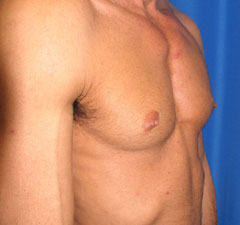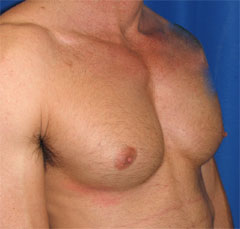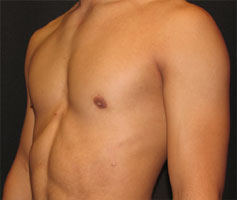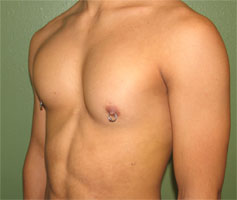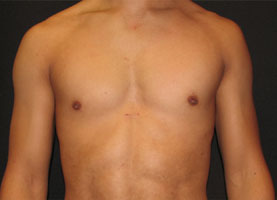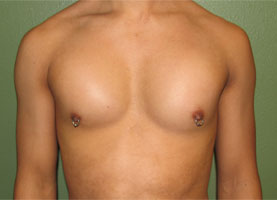What Are Pec Implants?
Pec implants are used in cosmetic (aesthetic) or reconstructive (functional) surgery procedures to increase the appearance, size or shape of the pectoral muscles. As such, they have been in use longer than most other types of body implants, (buttock, calf, bicep/tricep implants, etc.), first appearing in the mid-70s to repair functional issues such as asymmetry, and congenital chest deficiencies such as Poland’s Syndrome and Marfan Syndrome. Evolving from their original functional applications, they evolved in usage and are now used more widely in aesthetic applications—making enhancements to male physique. Much of the evolution of the procedure in both areas has been in the last 25 years, since the mid-90s.
Basic Anatomy of the Pectoral Muscle
The pectoral muscle is not a single muscle. It is composed of two distinct sets of muscle fibers—the Pectoralis Minor and the Pectoralis Major—each enabling a specific body or limb movement.
The Pectoralis Minor inserts at the lateral area (outside region) of the collarbone (clavicle) and extends over and underneath the larger pectoral muscle group, the Pectoralis Major, attaching to the lower ribs near the sternum. The Pectoralis Minor gives you the ability to dip your shoulder forward and inward. The Pectoralis Minor is composed of the muscle bands that are often more pronounced in body builders due to excessive development—yielding a well-defined, shaped “bottom” of the Pectoral structure that scores highly with judges.
The Pectoralis Major is a broad flat muscle, that begins at the humerus (upper arm, near armpit) and inserts along the sternum. The Pec Major muscle imparts volume and mass to the upper chest area and enables movement of the arm(s) across the front of the body.
Several motor nerves permeate these muscles and care must be taken to avoid damaging these neural structures during pectoral augmentation and your surgeon will know the exact anatomical placement of these vital nerves.
What Can I Expect Before Pec Implant Surgery?
There is a step-wise progression to pec implant augmentation. Following a series of steps, your surgeon will map out a realistic plan to help you achieve your specific needs and situation. Generally, he will closely follow the steps, below.
- Step One—Your Medical History is Evaluated by Your Surgeon – Your medical history including past blood work, prior nerve damage or injuries (trauma) if they exist, and your postoperative expectations are all reviewed. Neural stenosis, or prohibitive systemic issues, such as DM1 and DM2 (diabetes mellitus, juvenile or acquired), and your expectations as to what you’d like to see after the surgery are all components of this first step evaluation. Sometimes, it’s valuable to both you and your surgeon to review what you think a good pectoral definition is, realistically. At your first meeting, it’s sometimes valuable to show your surgeon the type of “look” you’d like to achieve using a photograph to compare pectoral shapes and they can discuss these objectives with you, so be prepared to bring one if you can.
- Step Two—Physical Evaluation of Your Existing Chest and Physique – While most men think they are “normal,” in physical appearance, they are usually very surprised to have the surgeon tell them then are not as symmetrical as they believe. Your surgeon will show you small diminutive differences between your right and left pec muscles after careful examination and measurements. They will then review skin elasticity and the underlying dermis and muscle structures. Finally, specific measurements and photographs are taken in both flexed and rested muscle positions. This will help your surgeon evaluate pectoralis major and pectoralis minor bone insertions and attachments.
- Step Three—Implant Measurement, Implant Size Discussions, Presurgical Clearance – Lastly, before your planned surgery date, you will decide with the help of your surgeon the appropriate prothesis (implant) for the procedure. Your surgeon will make suggestions to you about achieving the best, most natural appearance post-surgically. If he feels a custom implant will achieve the results you are seeking, he will take the appropriate measurements and make a cast for custom manufacture. This is often done for congenital disorders or trauma injuries, to achieve the best look.
The Surgical Procedure and Recovery Time?
After proper marking of the surgical area, and anesthesia, a two-inch incision (approximately) is made high in the armpit and a pocket is created using multiple dissection techniques, as appropriate. After separating the pectoralis major from the underlying ribs, the area is irrigated with a local anesthetic and a soft, solid silicone implant is modified as needed to specifically fit each patient and inserted into the pocket. After anchoring the implant to the chest wall and closing all incisions, a small dressing is placed under the arms and the area is wrapped with an elastic bandage to compress the surgical sites. The patient will be able to see the change immediately after surgery from the use of the pec implants.
During the recovery period, the patient is instructed limit arm motion and heavy lifting for a few days. After a few days, dressings are changed, and an elastic compression garment is applied to the area. The patient is instructed to wear the compression device for several weeks. After 1-2 weeks, a gentle exercise program will enable you to achieve a full and comfortable range of motion of the arms with full pectoral muscular activity shortly thereafter.
What Are Potential Risks & Complications?
Surgical risks are not excessive, but include infection, seroma/hematoma formation, bleeding, asymmetry, implant migration, capsular contraction, wound dehiscence, scarring, and muscle and/or nerve damage.
Aesthetic (cosmetic) Pectoral Implant Applications—
Society’s visual representation of what is considered the “perfect” male physique hasn’t changed dramatically over the last several hundred years. Evidenced in photographs, paintings, etchings, and older forms of visual art—portraying ancient Gods and demigods such as Hercules—males are depicted with well-developed pectoral muscles. These representations—accurate, or not, were indicative of more difficult challenges for survival compared to today and required the use of greater upper body strength for everyday tasks . . . hence the depictions of men with large pectoral-developed chests, shoulders and arms. Back then, pec muscles were the result of hard labor and work and not developed in the local gymnasium.
Fortunately, today’s male isn’t faced with the same living challenges as his ancestral kin, and as such, chest development is usually relegated to gym work, IF one has the chance to do it at all. In these cases, even with frequent exercise, men sometimes find that they are still unable to achieve the pectoral muscles that they desire . . . those chest muscles that appeal so much to the opposite sex. In these instances, pec implants are available to alleviate these problems and can cosmetically improve the look of a man’s upper chest. Using pec implants aesthetically, one can supplement, shape, enlarge, or firm existing chest muscles, helping attain the look you want while still allowing a natural appearance when the pectoral muscles are either flexed or relaxed.
Functional (congenital disorders, asymmetry) Pectoral Implant Applications—
Initially, pectoral augmentation using pec implants had its foundation in functional applications because of congenital issues or trauma. Birth defects such as Spina Bifida are genetic deformities that can alter the bone and musculature of the body. Fortunately, the number of instances involving Spina Bifida are not excessively large.
Functional applications, such as trauma caused by injury, however, show greater numbers of instances and usually vary by activity. For instance, bodybuilders typically sustain tears to the pec muscles during intensive training and sometimes healing can lead to visually unappealing results afterwards. Other injuries from collision sports such as football and automobile accidents or motorbike competitions can also lead to tears or dislocations of the pec muscles, and after corrective surgery to repair traumatized areas it’s sometimes necessary to utilize a pec implant to again achieve symmetrical balance after injury.
Lastly, some men have hormonal issues, lacking sufficient testosterone or having increased amounts of female hormones such as estrogen. These imbalances can sometimes be corrected with hormonal supplementation or sequestrants, but large amounts of adipose tissue (fatty tissue) can remain—making one seem like they are growing female breasts. While pectoral implants are not a cure for these ailments—depending on the extent of the disorder, they can help and provide anatomical balance in less serious cases. Our doctors are among the leading surgeons dealing with such disorders, and they can help people achieve the anatomical equilibrium they desire . . . using pec implants for functional disorders such as those listed below.
Pectus Carinatum is a condition whereby bone development surrounding the thoracic cavity often leaves the person with a protruding sternum, giving the appearance of a ‘pigeon chest’, a poor descriptor, but one commonly used to describe the condition. There are varying degrees of the birth defect, but in minor cases pec implants can be used to offset the protruding sternum, masking the defect, and yielding a more natural-appearing chest. Other musculoskeletal conditions associated with this defect are Marfan’s Syndrome and Poland’s Syndrome.
Pectus Excavatum is a bone affliction from a birth defect, whereby the ribs that fuse with the Sternum, are undeveloped/overdeveloped and concave, leaving the person with a sunken chest. Interestingly, the underlying organs are rarely affected, and it is only the visual representation that manifests the disorder. There are varying degrees of the birth defect, but in minor cases, pec implants can be used to offset the condition, masking the bone defect to yield a more visually-appearing, normal chest. Other musculoskeletal associated with this defect are Marfan’s Syndrome and Poland’s Syndrome.
Societal/Recreational Pectoral Implant Applications—
Gynecomastia, isn’t a term that most men want to hear when having someone describe their chest physique. Male “boobs” generally aren’t objects of pleasure for most members of the opposite sex. Yet today, gynecomastia has been described by the British Journal of Medicine as a male “epidemic” largely because of today’s changing lifestyles—societal modification—including being more sedentary. Generally, this enlargement of a male’s fatty tissue in the pectoral area is not related to hormonal imbalances (but can be), but rather increased obesity in developed nations in North America, Asia, and Europe because of fatty caloric-laden diets, IPA beer consumption, and legalization of cannabis products. Gynecomastia is now apparent in almost half of all men to varying degrees. With the acceptance of legalized cannabis products in the United States and in Europe, gynecomastia can be expected to only worsen.
While pec implants can help build or replace volume after fatty tissue is removed via gynecomastia surgery, they are not a cure for gynecomastia. Behavior modification and better eating habits, as well as more exercise can help in the long run. Pec implants will help with leveling the skin surface and removing wrinkles because they can replace the lost fatty tissue with a sculpted implant.
Before & After Photo Gallery


